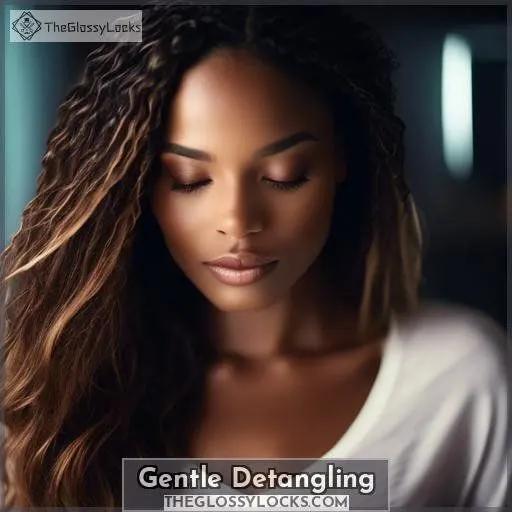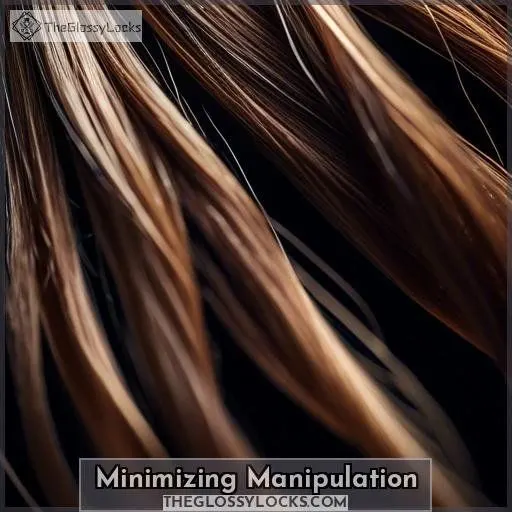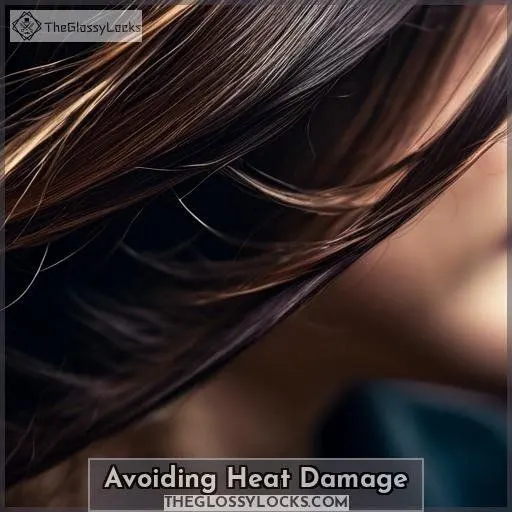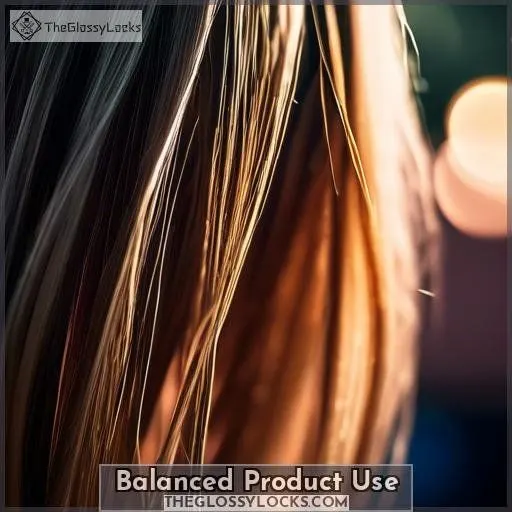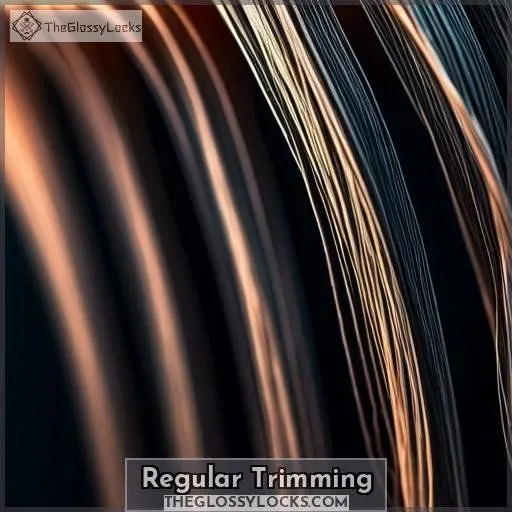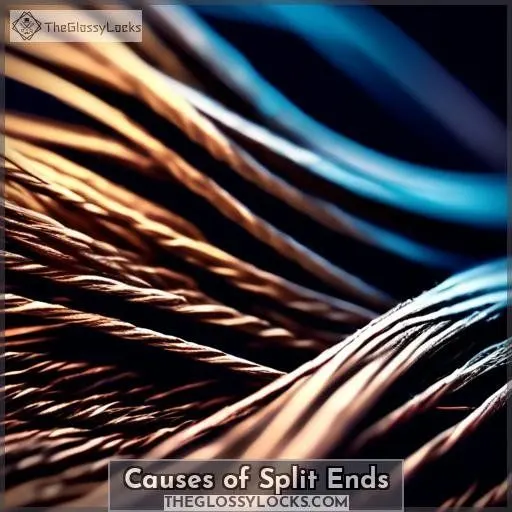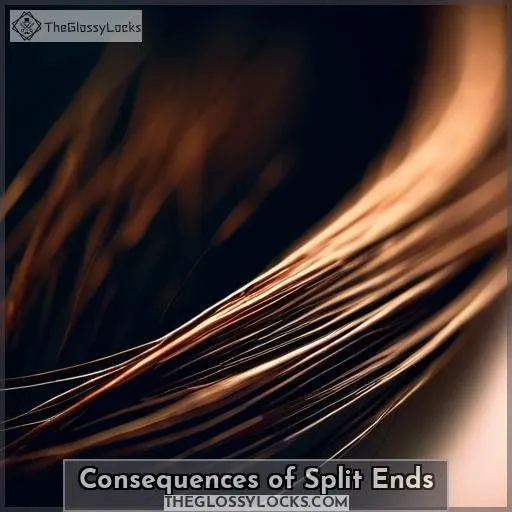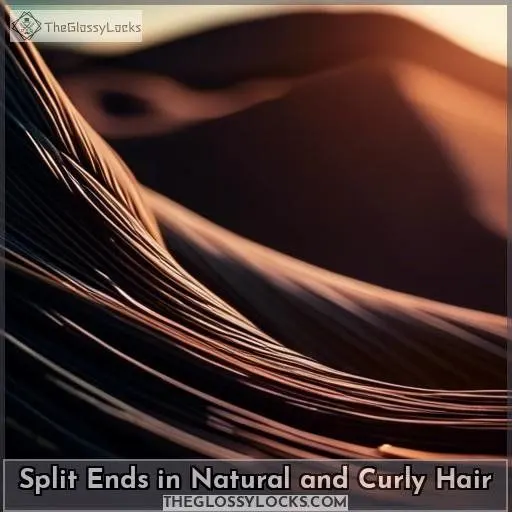This site is supported by our readers. We may earn a commission, at no cost to you, if you purchase through links.

You’re battling those pesky split ends in your luscious 4c curls?
Don’t fret!
Gentle detangling with a wide-tooth comb and slip-enhancing conditioners is key.
Minimize manipulation by embracing protective styles and using leave-in products.
Avoid heat damage by limiting hot tools and using heat protectants.
Nourish your strands with natural oils and deep conditioning treatments.
And, of course, regular trimming is essential to remove those split ends and promote healthy growth.
But there’s more to this story – let’s explore further into the causes, consequences, and specialized care for split ends in natural, curly tresses.
Table Of Contents
Key Takeaways
- Gentle detangling, minimizing manipulation, avoiding heat damage, and regular trimming are essential for preventing split ends in 4c hair.
- Deep conditioning and using natural oils can nourish the hair and protect it from damage.
- Balanced product use and avoiding harsh chemicals, sulfates, mineral oil, or petroleum jelly can help maintain healthy hair.
- Split ends are irreversible and can’t be healed, so regular trims are necessary to remove them and promote growth.
Gentle Detangling
To protect your 4c hair from split ends, start with gentle detangling.
Choose a conditioner with slip to make detangling easier and reduce breakage.
Apply hair masks for deep nourishment and frizz reduction.
Detangle and comb hair when wet, using a wide-tooth comb.
Balance product use to prevent hair from becoming fragile.
Deep condition regularly for strength and shine.
Minimizing Manipulation
To minimize manipulation and prevent damage to your 4C hair, consider the following tips:
- Detangle Techniques: Use a wide-tooth comb or your fingers to detangle your hair when it’s wet, as it’s less prone to breakage at this stage. Apply a detangling product like the Baobab Detangler and Cleanser to help smooth the hair and reduce tangles.
- Product Recommendations: Apply a leave-in conditioner or oil like Black Seed Oil to help keep your hair moisturized and reduce the risk of breakage.
- Protective Styling: Opt for protective hairstyles like braids, twists, or updos that can help protect your hair from damage and promote growth.
- Moisture Retention: Maintain moisture in your hair by using a satin or silk scarf or bonnet when sleeping, and applying a light-hold hairspray to keep your hairstyle in place.
- Scalp Health: Keep your scalp healthy by cleansing it regularly with a shampoo like the Baobab Detangler and Cleanser, and using a deep conditioning treatment like the Marula Leave In Conditioner to nourish your hair.
- Hair Care: Avoid using harsh chemicals, sulfates, mineral oil, or petroleum jelly, which can contribute to hair damage.
- Hair Damage and Breakage: Regular trims can help prevent split ends and breakages, and deep conditioning treatments can help strengthen your hair.
- Split Ends: If you notice split ends, it’s vital to cut them off to prevent further damage and promote hair growth.
Avoiding Heat Damage
Heat styling tools like blow dryers, flat irons, and curling irons can cause significant damage to your 4c hair, leading to split ends and breakage. To protect your locks, follow these tips:
- Use heat protectants: Apply silicone serums or heat protectants to shield your hair from heat damage. These products create a barrier between your hair and the heat source, minimizing damage.
- Limit heat styling: Reduce the frequency of using heat styling tools. If you must use them, set the temperature to the lowest setting and use them sparingly.
- Choose the right tools: Opt for ceramic or tourmaline-coated tools, which distribute heat evenly and cause less damage than traditional metal ones.
Balanced Product Use
Balancing your product use is essential for maintaining healthy hair and preventing split ends. Here’s how you can achieve this:
- Conditioning Routines: Regular conditioning is essential for maintaining hair health. Use a conditioner that suits your hair type and provides slip, reducing breakage during detangling.
- Product Ingredients: Look for hair products that are rich in natural oils and moisturizers. These ingredients help to hydrate your hair and protect it from damage.
- Deep Conditioning: Regular deep conditioning treatments can help to strengthen your hair and prevent split ends. These treatments provide extra nourishment to your hair, making it more resilient.
- Healthy Hair: Maintaining a healthy lifestyle, including a balanced diet and proper hydration, can help to prevent split ends.
- Split End Prevention: Use hair masks and hair oils to provide deep nourishment and frizz reduction. These products help to protect your hair from environmental factors and styling damage.
Regular Trimming
Maintaining the health of your curly hair is an ongoing endeavor, and routine trims are a vital element of that process.
Trimming your hair every 4-6 months, or more often if necessary, can help prevent split ends and encourage growth.
While trims done by professionals are optimal, home trims can also be effective with the appropriate tools and methods.
Healthy hair practices, such as using products in moderation and gently detangling, coupled with regular trims, will keep your curls looking vibrant and robust.
Definition and Types of Split Ends
Split ends form when the hair cuticle, the outermost layer of the hair strand, is damaged.
This can occur due to internal hair structure issues or external damage from styling, handling, or environmental factors.
Split ends can manifest as classic splits, multiple splits, thinning ends, or splits up the shaft.
They affect all hair types, including 4c hair, which is more prone to split ends due to its natural curl pattern.
Split ends can cause tangles, frizz, and breakage, leading to unhealthy-looking hair.
While hair split ends repair products can help temporarily, the best approach is to prevent split ends through gentle detangling, minimizing manipulation, avoiding heat damage, balanced product use, and regular trimming.
Causes of Split Ends
You’re likely no stranger to split ends if you have 4c hair.
These pesky damaged strands stem from preventative care lapses, environmental factors like excessive humidity or dryness, and certain hair care practices involving sulfates, mineral oil, or petroleum jelly.
While split ends are an inevitable part of the hair journey, being mindful of the causes can help minimize their formation and keep your coils luscious.
Preventative Care
Prevent split ends by using pre-shampoo treatments, detangling tools, hair oils, and repair products. Balance product use and avoid over-manipulation.
Environmental Factors
Shield your locks from climate conditions; balance moisture, dodge sun, and master humidity with strategic hair accessories.
such as excessive humidity
Humidity can wreak havoc on your hair, causing it to become frizzy and prone to split ends. When humidity levels are high, your hair absorbs moisture from the air, causing the cuticle to lift and exposing the inner cortex. This can lead to split ends, which are irreversible and can cause further damage to your hair. To prevent split ends caused by humidity, consider the following tips:
- Use sulfate-free shampoos: Sulfates can strip your hair of its natural oils, making it more prone to damage from humidity. Opt for sulfate-free shampoos to maintain your hair’s natural moisture balance.
- Apply a deep conditioner: Regular deep conditioning can help nourish and strengthen your hair, making it less susceptible to damage from humidity.
- Protect your hair at night: Wear a satin or silk bonnet or use a silk or satin pillowcase to reduce friction and protect your hair from breakage while you sleep.
- Avoid excessive heat styling: Heat tools can damage your hair, making it more vulnerable to humidity-related damage.
- Stay hydrated: Dehydration can exacerbate the effects of humidity on your hair. Make sure to drink plenty of water and maintain a balanced diet to keep your hair and body healthy.
dryness
After addressing humidity, let’s delve into dryness, a well-known split-end accomplice in 4c hair.
- Embrace hair oils for unparalleled hydration.
- Swear by deep conditioning to seal in moisture.
- Don’t skimp on hair vitamins for internal fortitude.
rain
Rain can be a double-edged sword for your hair. On the one hand, it can help to restore your hair to its natural texture, especially for those with curly hair. On the other hand, it can cause frizz and make your hair more prone to tangling. Here are some ways to minimize the negative effects of rain on your hair:
- Use a leave-in conditioner: Apply a leave-in conditioner before going out in the rain to create a barrier on your hair and minimize the negative effects of rainwater.
- Rinse your hair: If your hair gets wet in the rain, rinse it with clean water as soon as possible to remove any pollutants or contaminants that might’ve settled on your hair.
- Opt for gentle hair products: Use gentle, sulfate-free shampoos and nourishing conditioners to cleanse and hydrate your hair without stripping away natural oils.
- Use a microfibre towel: Dry your hair with a microfibre towel, which is gentler on your hair strands than a regular towel.
- Tie your hair up: When your hair is finally dry, tie it up into buns or plaits to avoid frizzy hair and maintain the texture of your hair.
- Eat a balanced diet: Maintain a balanced and protein-rich diet to nourish your hair from the inside out.
- Avoid heat styling: Heat styling can cause dryness and split ends, which can be exacerbated by rain.
or sun
Sun exposure can substantially harm your hair, resulting in fragility, dryness, and split ends. UV rays decompose the proteins that constitute your hair, causing discoloration and protein depletion. To safeguard your hair from sun damage, adhere to these guidelines:
- Maintain your hair’s hydration: Ingest ample fluids and utilize deep conditioning treatments to retain moisture prior to sun exposure.
- Reduce shampoo frequency: Limit hair washing to alternate days to prevent the removal of natural oils.
- Apply SPF to exposed areas: Ensure the protection of your scalp, temples, ears, and hair part.
- Seek shelter from the sun or create your own: Utilize wide-brimmed hats, umbrellas, and sunglasses for further protection.
- Employ a heat protectant: Apply a heat protectant to your hair before sun exposure to create a barrier between your hair strands and the sun.
Hair Care Practices
After battling the sun, focus on moisture management, protective styling, and hydration maintenance for thriving curls.
such as sulfates
Sulfates are a type of additive commonly found in hair care products, including shampoos and conditioners. They’re responsible for creating the lather and suds that many people associate with clean hair. However, sulfates can also strip hair of its natural moisture, leading to dryness and increased breakage. Sulfates can be derived from petroleum oil, coconut or palm oil, and are used to trap oil and dirt in hair so they can be easily washed away.
Sulfates are particularly problematic for curly hair, as they can cause frizz and breakage. For those with color-treated hair, sulfates can strip the hair of its color, leading to faster fading. To avoid the negative effects of sulfates, many people opt for sulfate-free hair care products, which are designed to be gentler on the hair and scalp. These products often contain natural ingredients and are marketed as being better for hair health and appearance.
mineral oil
Mineral oil is a hydrocarbon-based product derived from petroleum. It’s commonly used in hair care products due to its ability to form a barrier on the hair shaft, trapping other products, oils, and debris. This barrier can help to lock in moisture, reduce frizz, and improve hair structure. However, mineral oil can also produce a heavy, oily feel on the hair, and some people may find it too heavy or greasy for their liking. Additionally, mineral oil can cause buildup on the scalp and hair strands, which can lead to a dull, lifeless appearance. It’s also worth noting that mineral oil isn’t a natural ingredient and may not be suitable for those who prefer to use natural or organic hair care products.
Mineral oil can be particularly beneficial for those with dry or damaged hair, as it can help to seal in moisture and protect the hair from further damage. However, it’s essential to use mineral oil in moderation, as excessive use can lead to buildup and a heavy, weighed-down appearance. It’s also recommended to use mineral oil in conjunction with other hair care products, such as shampoo and conditioner, to make sure that the hair is properly cleansed and nourished.
In terms of its impact on split ends, mineral oil can help to reduce the appearance of split ends by smoothing the hair cuticle and sealing in moisture. However, it’s important to note that mineral oil doesn’t actually repair or heal split ends; it only masks their appearance. To truly address split ends, it’s necessary to use hair care products that promote hair strength and repair, such as protein-rich conditioners and hair masks.
and petroleum jelly
Avoid using mineral oil and petroleum jelly on your hair, as they can cause damage and make your hair more prone to split ends. Instead, opt for natural oils like coconut oil, olive oil, castor oil, shea butter, and almond oil to protect and repair your hair.
Consequences of Split Ends
Split ends are a common issue for those with curly hair, as the hair type is more prone to dryness and frizz. These split ends can lead to breakage, shedding, and a decrease in the overall health of your hair. They can also make your hair appear frizzy and unhealthy, which can be frustrating for those who want to maintain luscious curls. However, there are ways to prevent and treat split ends to keep your hair looking its best.
First, it’s important to understand the causes of split ends. They can occur due to physical damage from styling, brushing, detangling, handling, touching, heat tools, friction from fabrics, and environmental factors like extreme weather conditions. Additionally, internal factors such as diet, hydration, and overall health can also contribute to split ends.
To prevent split ends, it’s vital to be gentle with your hair. Use conditioners for slip and reduced breakage, apply hair masks for deep nourishment and frizz reduction, and avoid frequent styling to minimize frizz and breakage. Detangle and comb your hair when it’s wet, and balance your product use to prevent your hair from becoming fragile. Regular trims are also essential to remove dead hair and prevent breakage.
If you already have split ends, the best course of action is to cut them off with sharp shears. Trim regularly (every 4-6 months or sooner) and remove ¼ – ½ inch with each trim. Split ends are irreversible and can’t be healed, so it’s important to remove them before they cause further damage.
Split Ends in Natural and Curly Hair
Exploring the realm of 4c hair care, you embark on a mission not merely for growth but for dominion over those vexing split ends.
Envision split end prevention as your fortress against the shrinkage demon, shielding your realm of ringlets from fragmentation and assuring your hair’s well-being and expanse.
Dismiss drastic remedies such as transplants, extensions, disguises, toppers, or enhancements.
With proper care, your inherent grandeur is unparalleled.
Thus, equip yourself with wisdom and let your radiant coils prevail!
Conclusion
Are you tired of battling with split ends in your 4c hair? Implementing proper detangling techniques, minimizing manipulation, avoiding heat damage, utilizing balanced products, and regular trimming can effectively combat split ends. By understanding the causes, consequences, and specialized care required for split ends in natural, curly tresses, you’ll be well-equipped to achieve luscious, healthy 4c hair.

